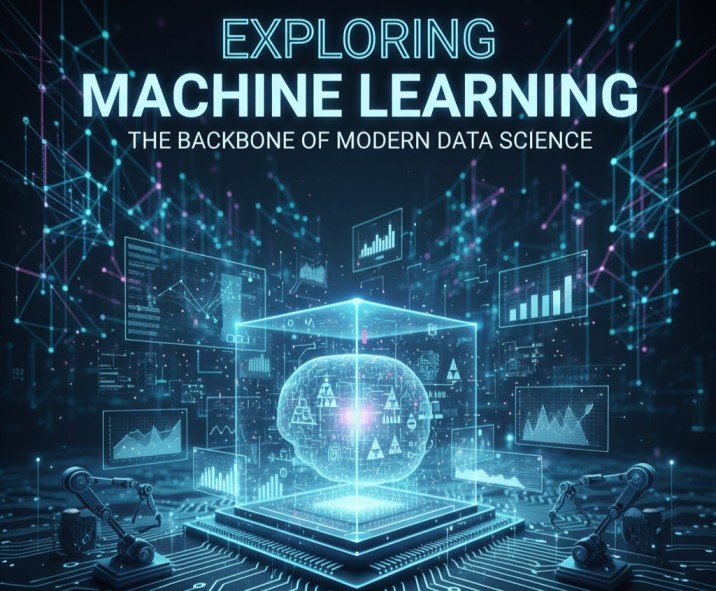Machine learning (ML) has emerged as the backbone of modern data science, revolutionizing the way businesses and industries approach problem-solving. By enabling systems to learn and improve from experience without explicit programming, ML has become a powerful tool for making data-driven decisions. From healthcare to e-commerce, its applications are transforming industries, providing insights, automating processes, and enhancing efficiency.
In this article, we delve into the essence of machine learning, its types, applications, and the pivotal role it plays in shaping the future of data science.
What is Machine Learning?
Machine learning is a subset of artificial intelligence (AI) that uses algorithms and statistical models to analyze and interpret data, allowing systems to identify patterns and make predictions. Unlike traditional programming, where explicit instructions are required, ML enables systems to learn from data and improve over time.
Types of Machine Learning
- Supervised Learning
- In supervised learning, models are trained on labeled datasets, meaning the input data has corresponding output labels.
- Examples:
- Predicting house prices based on historical data (regression).
- Classifying emails as spam or non-spam (classification).
- Unsupervised Learning
- Here, the model is provided with unlabeled data and tasked with finding patterns or groupings.
- Examples:
- Customer segmentation for personalized marketing (clustering).
- Identifying anomalies in network traffic (anomaly detection).
- Reinforcement Learning
- This type involves training agents to make decisions by interacting with an environment and receiving feedback in the form of rewards or penalties.
- Examples:
- Self-driving cars.
- AI systems playing strategic games like chess.
Applications of Machine Learning in Data Science
- Predictive Analytics
- ML models can analyze historical data to predict future trends, enabling businesses to make proactive decisions.
- Example: Forecasting stock prices or customer demand.
- Natural Language Processing (NLP)
- NLP enables machines to understand and process human language.
- Example: Chatbots providing customer support and sentiment analysis for brand reputation.
- Image and Speech Recognition
- ML models excel at recognizing patterns in visual and auditory data.
- Example: Facial recognition for security and voice assistants like Alexa or Siri.
- Fraud Detection
- Financial institutions use ML to analyze transaction patterns and flag fraudulent activities.
- Example: Identifying credit card fraud in real-time.
- Recommendation Systems
- ML drives personalized recommendations by analyzing user behavior and preferences.
- Example: Netflix suggesting movies or Amazon recommending products.
Why Machine Learning is Essential to Data Science
- Scalability
- Machine learning allows data scientists to handle vast amounts of data efficiently, scaling operations without manual intervention.
- Automation
- ML automates repetitive tasks, freeing up resources for strategic activities.
- Example: Automating data preprocessing and anomaly detection.
- Real-Time Insights
- ML models process data in real-time, providing immediate insights and enabling quick decision-making.
- Adaptability
- Unlike static models, ML systems adapt to new data, improving accuracy and relevance over time.
Challenges in Machine Learning
- Data Quality
- Poor-quality data can lead to inaccurate models and unreliable predictions.
- Model Interpretability
- Complex models, like deep learning, can be difficult to interpret, raising concerns in critical applications like healthcare.
- Bias and Ethics
- ML models can inadvertently learn biases present in the training data, leading to ethical dilemmas.
- Computational Costs
- Training and deploying ML models require significant computational resources, which can be expensive.
The Future of Machine Learning in Data Science
As machine learning evolves, its integration with emerging technologies will further amplify its impact:
- AI-Powered Automation: Enhanced automation of workflows, reducing human intervention.
- Edge Computing: Real-time ML processing at the edge, reducing latency and improving efficiency.
- Explainable AI: Making ML models more interpretable and transparent for critical decision-making.
- Quantum Machine Learning: Harnessing the power of quantum computing for solving complex problems faster.
Conclusion
Machine learning stands at the core of modern data science, transforming raw data into actionable insights that drive innovation and efficiency. By empowering systems to learn, adapt, and predict, ML is shaping the future of industries and redefining what’s possible in a data-driven world.
As businesses continue to adopt machine learning, it’s vital to focus on data quality, ethical considerations, and continuous innovation. By leveraging its full potential, organizations can gain a competitive edge, streamline operations, and create personalized experiences for their users.
Whether you’re a beginner in data science or an experienced professional, understanding and applying machine learning is essential to unlocking the true power of data.









